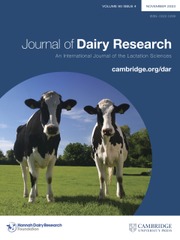No CrossRef data available.
Article contents
Metabolic disorders are genetically correlated with the production and reproductive performance of dairy cows: a meta-analysis
Published online by Cambridge University Press: 24 October 2025
Abstract
The present study aimed to conduct a meta-analysis using the random-effects model to merge published genetic parameter estimates for metabolic disorders [mastitis (MA), metritis (ME), ketosis (KE), milk fever (MF), retained placenta (RP), displaced abomasum (DA), and lameness (LA)] in dairy cows. A total of 239 heritability and 355 genetic correlation estimates were extracted from 61 peer-reviewed articles published between 1991 and 2024. Heritability estimates for metabolic disorders were generally low, ranging from 0.034 for ME to 0.067 for DA and MF. These estimates were associated with small standard errors and narrow 95% confidence intervals, with all estimates being statistically significant (P < 0.05). The estimates for genetic correlations between metabolic disorders were positive, ranging from 0.038 (MA-DA) to 0.522 (KE-DA). Furthermore, only the genetic correlations for DA-LA (0.147), RP-ME (0.472), MA-LA (0.239), MA-MF (0.365), KE-DA (0.522), KE-RP (0.124), and KE-ME (0.157) were significant (P < 0.05). Positive and low genetic correlations were observed between MA-milk yield (MY), MF-MY, and LA-MY (0.291, 0.135, and 0.263, respectively; P < 0.05). Similarly, positive correlations were found between DA-fat yield (FY), MA-FY, MA-protein yield (PY), LA-FY, and LA-PY (0.121, 0.170, 0.303, 0.176, and 0.236, respectively; P < 0.05). The genetic correlations between KE-fat to protein ratio (FPR) and DA-FPR were positive and ranged from low to moderate (0.520 and 0.196, respectively; P < 0.05). Significant genetic correlations were also noted between MA-days open (DO) (0.416), MA-days from calving to first service (DCFS) (0.207), and LA-calving interval (CI) (0.210; P < 0.05). This meta-analysis provides valuable insights into the genetic contribution to metabolic disorders in dairy cows and highlights the generally low heritability and the variable genetic correlations between these disorders and performance traits. These findings may contribute to more effective breeding strategies aimed at reducing the occurrence of metabolic disorders in dairy herds.
Information
- Type
- Research Article
- Information
- Copyright
- © The Author(s), 2025. Published by Cambridge University Press on behalf of Hannah Dairy Research Foundation.

